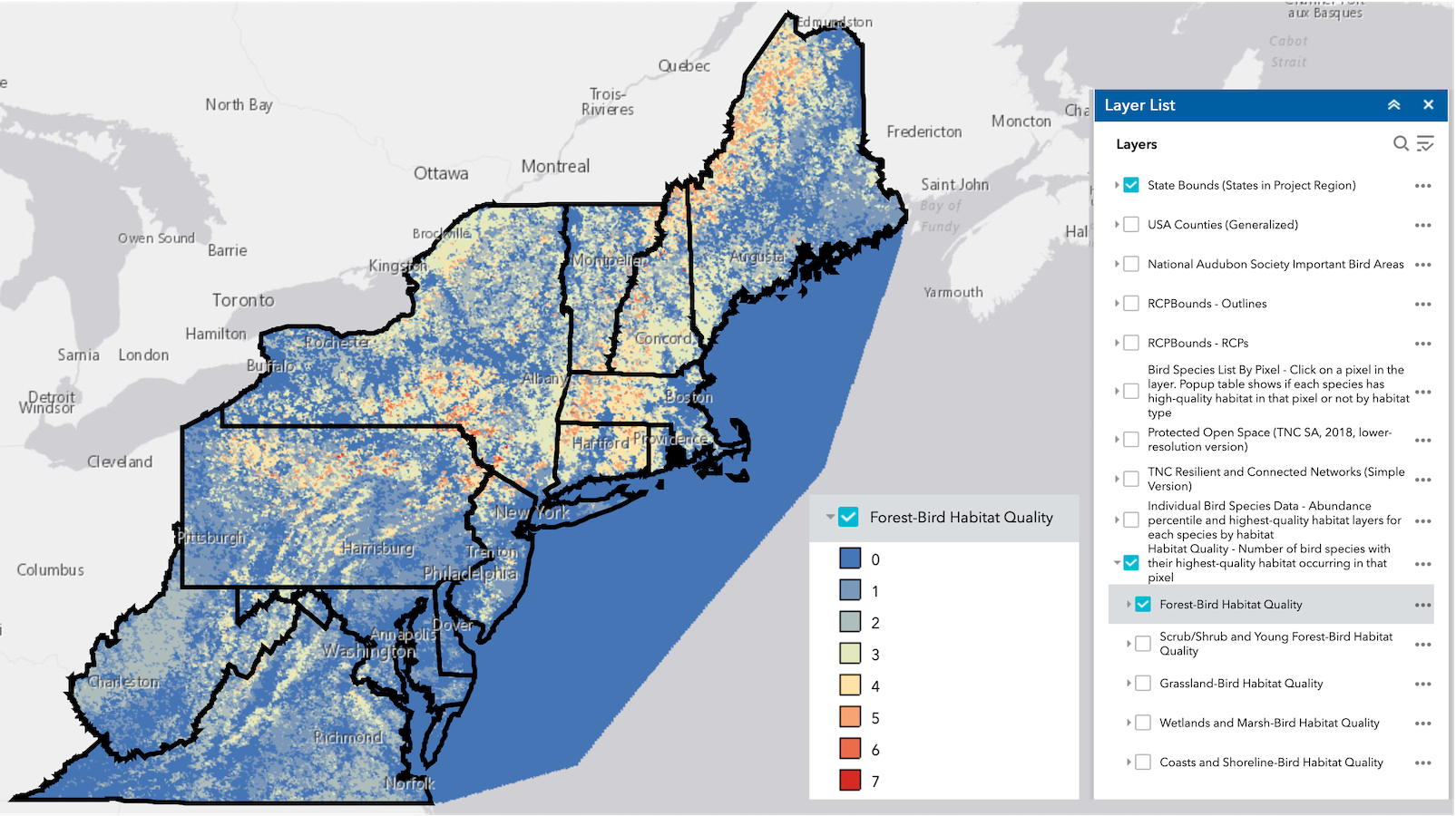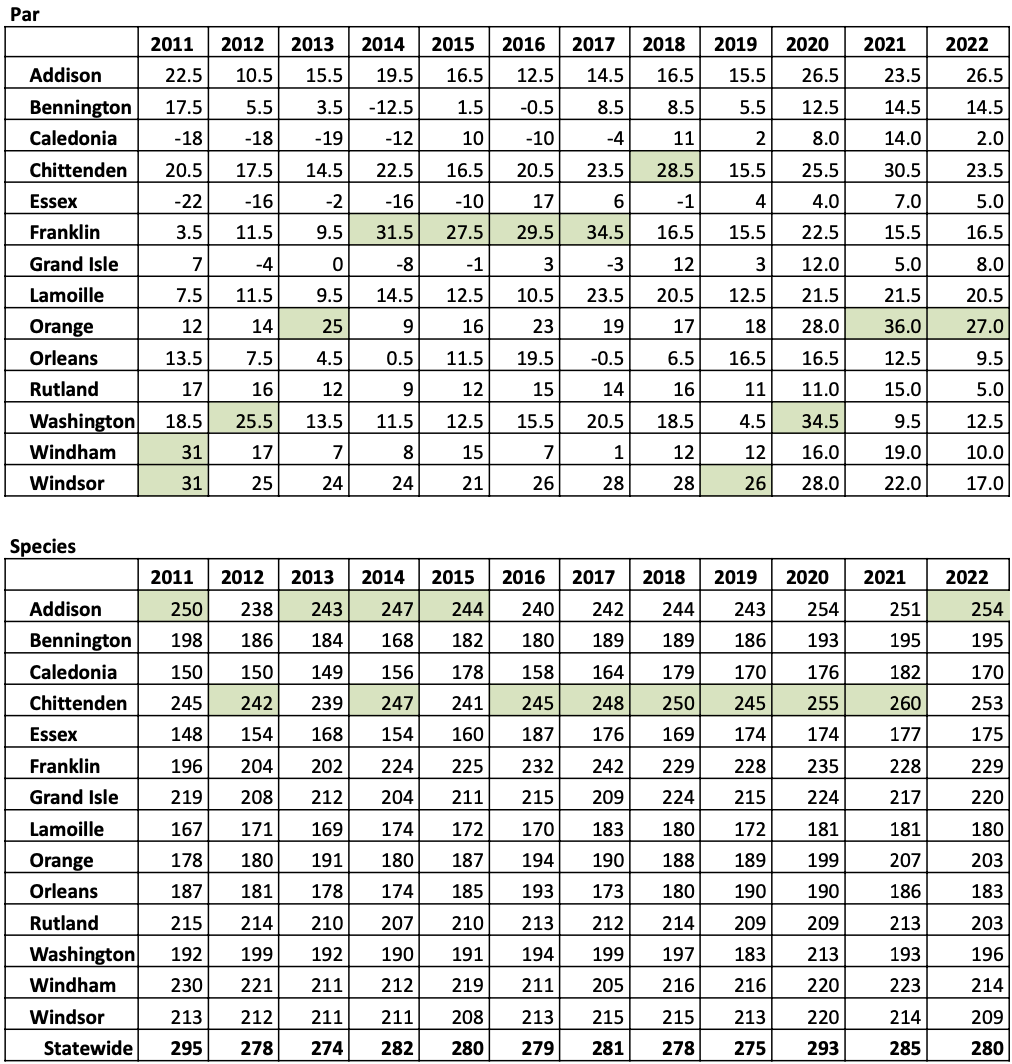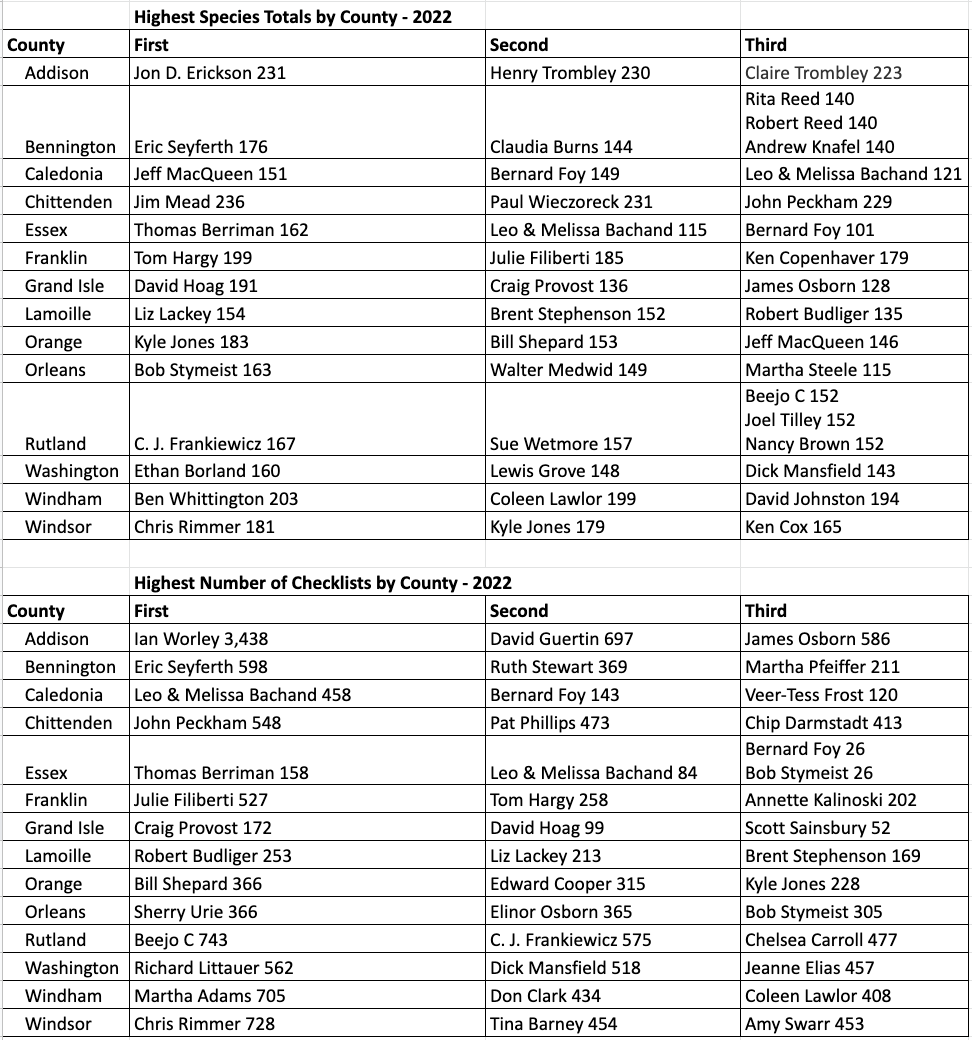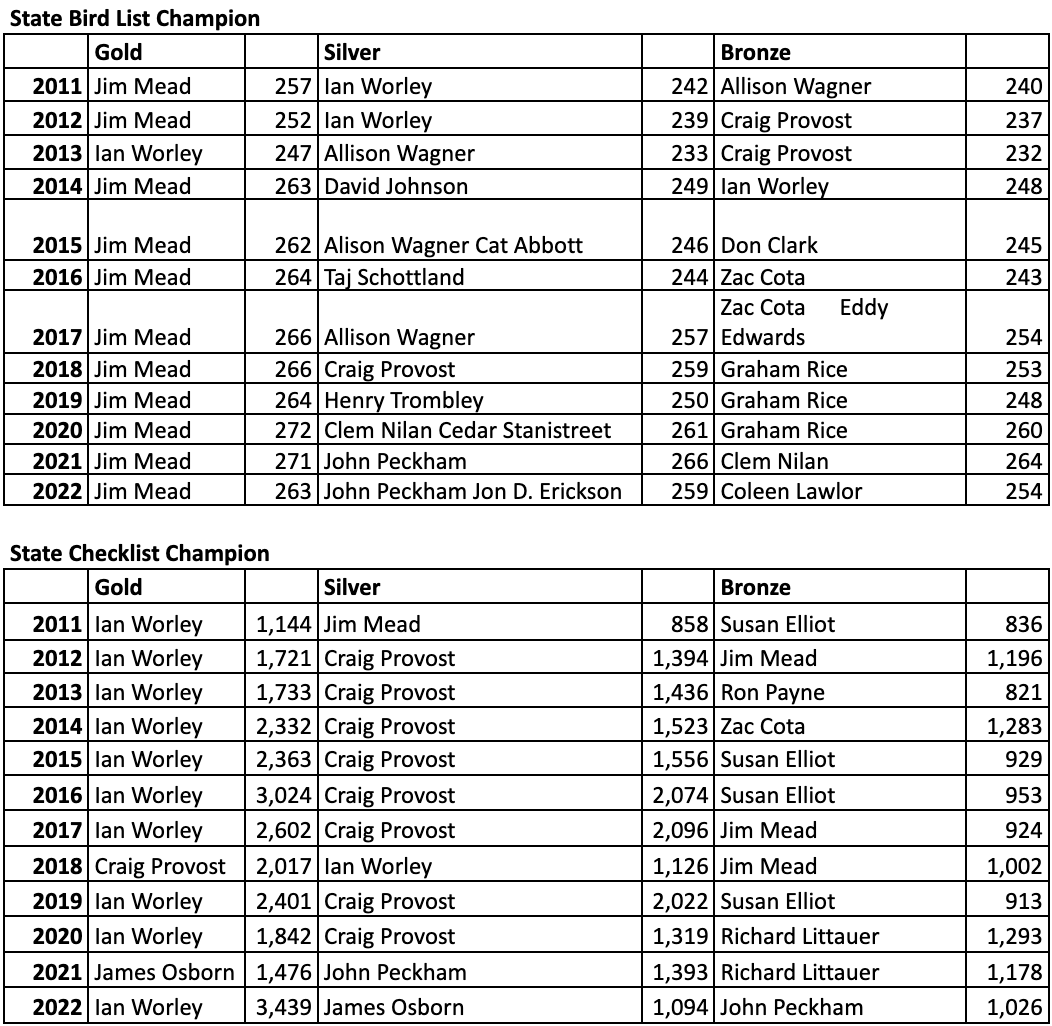With another banner birding year in the books, it’s time to look back on all that Vermont birders have accomplished in 2022. From the Northeast Kingdom to the Massachusetts border, from the Connecticut River valley to the Champlain valley, Vermont’s vast birding community once again took part in the Vermont eBird County Quest. In its 12th year, this event continued to bolster Vermont’s enormous database of bird sightings all in the spirit of friendly competition.
The annual year-long contest pits county versus county, birder against birder, all engaged in a friendly rivalry for top birding honors. The main idea behind the year-long Quest is simply to get people out birding, promote camaraderie, and better document bird life across the state using Vermont eBird.
2022 marked the 19th year for Vermont eBird, the first state or provincial portal for eBird. Bird watchers have shared an astounding number of checklists, making Vermont eBird (a project of the Vermont Atlas of Life) the largest community science biodiversity project in the state. In 2022 alone 10,007 eBirders in Vermont contributed a grand total of 102,170 checklists.
Since 2003, more than 13,800 Vermont eBirders have submitted more than 625,000 complete checklists, representing all 391 species of birds ever reported from Vermont. We’ve added over 170,000 images, over 16,000 sound recordings, and 275 videos to Vermont checklists, creating an incredible open access resource for all.
It isn’t just about Vermont. More than 1.3 billion bird sightings have now been entered into eBird worldwide. This includes more than 225 million observations submitted this year. eBird records now make up more than half of all all biodiversity data in the Global Biodiversity Information Facility (GBIF).
Science and Conservation
And, of course, eBird isn’t all just for fun. It’s for science and conservation, too. 2022 was another milestone year for eBird, delivering a new era of scientific and conservation applications, innovative new birding tools, and much more. As always, all of this is 100% free of charge to anyone who wishes to use it.
With eBird’s continued growth and the constant supply of valuable bird observations flowing in, the eBird status and trends project has continued to expand, now providing model abundance and range maps for 2,068 species. These maps are newly interactive, and eBirders can now zoom and pan across a species’ entire global range map. New, highly detailed trend maps have also been made available for 586 species around the world. These maps are built from data submitted by eBirders, and provide immensely useful information about where bird populations are booming or declining.

This map depicts the cumulative change in estimated relative abundance for Bicknell’s Thrush from 2007 through 2021 with circles representing 27km x 27km regions. Red indicates decline and blue indicates increase. The darker the color, the stronger the trend. White circles represent locations where the trend estimate is not significantly different from zero (i.e., the 80% confidence interval contains zero). Circle sizes are scaled by the estimated relative abundance at the middle of the time period.
A new and exciting GIS mapping tool from the Northeast Habitat Conservation Initiative uses eBird Status & Trends breeding season data for 43 species of conservation priority across the eastern United States to inform conservation and land management efforts.

Map of the northeastern US depicting the number of forest-associated bird species of conservation importance estimated to have high-quality habitat within a 2.7 km (1.6 mi) square pixel. Colors range from blue (indicating no forest species of conservation priority have high-quality habitat in that pixel) to red (all 7 forest bird species of conservation importance have high-quality habitat within that pixel).
Researchers published 160 peer-reviewed publications in 2022 incorporating eBird data bringing the total number of scientific publications using eBird data to more than 780. Scientists published 56 scientific papers this year using media assets from the Macaulay Library. Audio recordings uploaded to the Macaulay Library powered new and innovative research into how birds respond to alarm calls. Meanwhile, photographs uploaded to the Macaulay Library were used this year to identify a hybrid fairywren and to better understand when and how hummingbirds replace their feathers.
The 12th Annual Vermont eBird County Quest Champions
With 27 birds over par, Orange County had another amazing birding year, claiming the top spot for the second year in a row. Congratulations to all the birders who helped the county claim the 2022 Quest Cup. Addison County, one of the ‘birdiest’ counties in Vermont, placed a very close second with 26.5 birds over par.
The County Cup award is based on a carefully calculated “par” system, recognizing that not all Vermont counties are created equal in terms of avian diversity. Par scores reflect the number of species that a given county should find in a year with consistent birding effort. Each year a particular county wins, five birds are added to their par.
For the first time since 2015, Addison County has wrested the top spot away from the perennial favorite, Chittenden County, with a final total of 254 species. Chittenden County finished only a single species behind, claiming second place with 253 species.
Individual County Winners
These titles are awarded to the birders with the most checklists for each county and to the birders with the highest species count for each county. No par or weighting necessary for this one!
Visit the Vermont eBird Top 100 list to get a full tally of Checklist and Species List Champions for any year. Simply select the county and year you are interested and see where you ranked, too!
Statewide Winners
Many birders ventured outside their home county, of course. Jim Mead continued his dominance in total species observed with a final tally of 263 species, followed closely behind by John Peckham and Jon D. Erickson in a two-way tie for second place, both with 259 species. With a species total of 254, the 3rd place spot goes to Coleen Lawlor for her first top-3 finish in these rankings. Ian Worley racked up the most checklists in 2022 with a whopping 3,439. James Osborn and John Peckham both cruised over the 1,000-checklist mark to finish 2nd and 3rd with 1,094 and 1,026 checklists, respectively.
The County 150 Club
eBirders who identified 150 species or more in a county are inducted into the prestigious “150 Club.” Even in counties with higher avian diversity, a birder must be dedicated and in the field during all four seasons to join this club. Twenty Vermont eBirders added their names to the roll in 2022. Check out the 150 Club honor roll to see how you and your birding friends have done.
The Vermont 250 Club
The Vermont 250 Club requires even more dedication. This is a list of eBirders who’ve found 250 or more bird species in Vermont during one calendar year and reported them to Vermont eBird. To complete this, birders have to find about 90% of the species found in Vermont in any given year. Jim Mead has passed 250 species 11 times as of this year! A new addition to the 250 Club this year is Coleen Lawlor, congrats!
Cat Abbott (2018)
Zac Cota (2017)
Jacob Crawford (2021)
Eddy Edwards (2017)
Jon D. Erickson (2021, 2022)
Coleen Lawlor (2022)
Bill Mayville (2017)
Mae Mayville (2017)
Jim Mead (2011, 2012, 2014, 2015, 2016, 2017, 2018, 2019, 2020, 2021, 2022)
Clem Nilan (2018, 2020, 2021)
John Peckham (2021, 2022)
Craig Provost (2018)
Graham Rice (2018, 2020)
Cedar Stanistreet (2020)
Allan Strong (2021)
Henry Trombley (2019, 2020, 2022)
Alison Wagner (2017)
You can see the entire ranked list for each year by visiting the Vermont eBird Top 100.
Congratulations to everyone for a fun year of birding! We hope some of you will vie for top honors in 2023. You can follow the scoreboard all year long and see where you rank. Even if you come up short, all of the data collected in Vermont eBird is valuable for science, education, and conservation. Best of luck eBirding!
Thank You to All our Volunteers, Collaborators and Sponsors!
We’d like to thank the volunteer data experts that help us keep Vermont eBird data strong – Zac Cota, Jacob Crawford, Sue Elliott, Kyle Jones, Craig Provost, Nathaniel Sharp, and Ian Worley. Every record entered into Vermont eBird is checked for accuracy, first by automated filters that flag unusual records, and then by expert reviewers who devote their personal time to ensure that your lists and the eBird database are as accurate as possible. Additionally, Ron Payne, and Ian Worley are hotspot editors for Vermont. If you run into them while out birding, let them know you are thankful for their hard work and contribution behind the scenes at Vermont eBird.
And finally, thank you to all of Vermont eBird collaborators and sponsors that help make Vermont eBird a special place.




